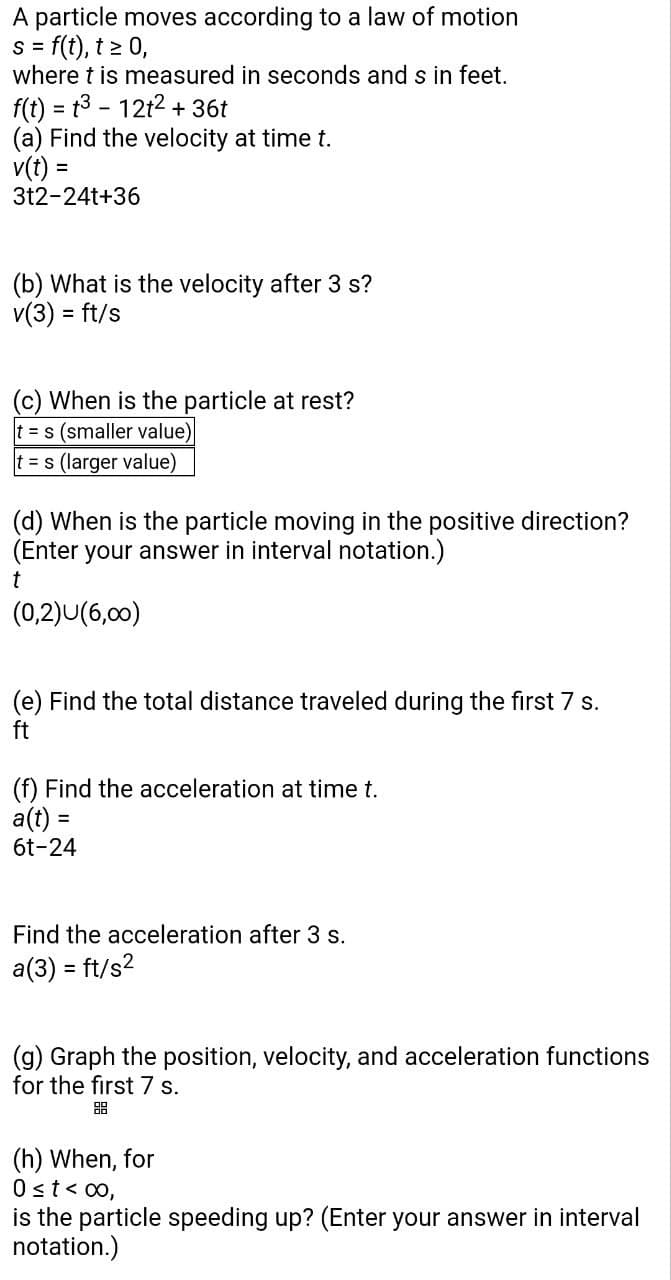A particle moves according to a law of motion s = f(t), t≥ 0, where t is measured in seconds and s in feet. f(t) = t3 12t2 + 36t (a) Find the velocity at time t. v(t) = 3t2-24t+36 (b) What is the velocity after 3 s? v(3) = ft/s (c) When is the particle at rest? t=s (smaller value) t=s (larger value)
A particle moves according to a law of motion s = f(t), t≥ 0, where t is measured in seconds and s in feet. f(t) = t3 12t2 + 36t (a) Find the velocity at time t. v(t) = 3t2-24t+36 (b) What is the velocity after 3 s? v(3) = ft/s (c) When is the particle at rest? t=s (smaller value) t=s (larger value)
Principles of Physics: A Calculus-Based Text
5th Edition
ISBN:9781133104261
Author:Raymond A. Serway, John W. Jewett
Publisher:Raymond A. Serway, John W. Jewett
Chapter1: Introduction And Vectors
Section: Chapter Questions
Problem 69P: A pirate has buried his treasure on an island with five trees located at the points (30.0 m, 20.0...
Related questions
Question

Transcribed Image Text:A particle moves according to a law of motion
s = f(t), t≥ 0,
where t is measured in seconds and s in feet.
f(t) = t³ - 12t² + 36t
(a) Find the velocity at time t.
=
v(t)
3t2-24t+36
(b) What is the velocity after 3 s?
v(3) = ft/s
(c) When is the particle at rest?
t = s (smaller value)
t = s (larger value)
(d) When is the particle moving in the positive direction?
(Enter your answer in interval notation.)
t
(0,2)U(6,00)
(e) Find the total distance traveled during the first 7 s.
ft
(f) Find the acceleration at time t.
a(t) =
=
6t-24
Find the acceleration after 3 s.
a(3) = ft/s²2
(g) Graph the position, velocity, and acceleration functions
for the first 7 s.
(h) When, for
0 ≤ t < 00,
is the particle speeding up? (Enter your answer in interval
notation.)
Expert Solution
This question has been solved!
Explore an expertly crafted, step-by-step solution for a thorough understanding of key concepts.
This is a popular solution!
Trending now
This is a popular solution!
Step by step
Solved in 6 steps

Knowledge Booster
Learn more about
Need a deep-dive on the concept behind this application? Look no further. Learn more about this topic, physics and related others by exploring similar questions and additional content below.Recommended textbooks for you

Principles of Physics: A Calculus-Based Text
Physics
ISBN:
9781133104261
Author:
Raymond A. Serway, John W. Jewett
Publisher:
Cengage Learning

Physics for Scientists and Engineers: Foundations…
Physics
ISBN:
9781133939146
Author:
Katz, Debora M.
Publisher:
Cengage Learning

Classical Dynamics of Particles and Systems
Physics
ISBN:
9780534408961
Author:
Stephen T. Thornton, Jerry B. Marion
Publisher:
Cengage Learning

Principles of Physics: A Calculus-Based Text
Physics
ISBN:
9781133104261
Author:
Raymond A. Serway, John W. Jewett
Publisher:
Cengage Learning

Physics for Scientists and Engineers: Foundations…
Physics
ISBN:
9781133939146
Author:
Katz, Debora M.
Publisher:
Cengage Learning

Classical Dynamics of Particles and Systems
Physics
ISBN:
9780534408961
Author:
Stephen T. Thornton, Jerry B. Marion
Publisher:
Cengage Learning